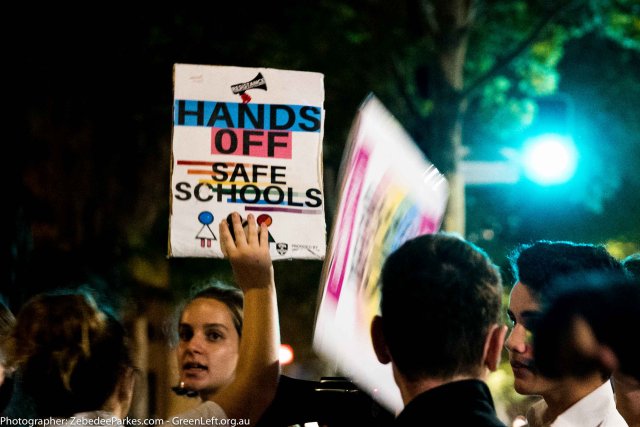
Over the Easter weekend, the Safe Schools program was gutted in NSW. Education minister Rob Stokes announced that the program would not be funded when federal government support ends later this year. The rights of LGBTQI youth were eroded not with a bang, but with a murmur — and a Miranda Devine article.
Devine tells us in a Daily Telegraph article on April 19 that like a virus, queerness can be transmitted to otherwise straight, cisgender children just by exposing them to its existence. Most damagingly, though, she tells us that the Safe Schools program created an “epidemic” of trans children in the schools it reached.
Miranda Devine, and every other conservative commentator who has cheered the axing of the program, I’d like you to take a moment to think what it might have been like to grow up feeling unsafe, alone and terrified, with the sinking suspicion that there was something inside you that was different to your friends.
Imagine being afraid to share that thing that you didn’t have a name for and didn’t have a way of explaining until long after you’d slipped off your school uniform and finally been exposed to the complexity of sexuality?
Imagine finally being able to understand yourself in a way you’d never imagined?
Imagine how powerful and affirming that might feel.
Now imagine skipping some of the years of anguish, and being able to have the complexities of gender articulated to you in the safety of your PDHPE classroom, by an authority figure who has been given the tools to ensure that they have control of the conversation.
Programs like Safe Schools don’t “create” more LGBTQI kids. They create safe, supported LGBTI kids, as opposed to closeted, depressed LGBTQI kids.
Increasing numbers of openly trans kids shows that the program is working. It shows that people are learning, and growing. Isn’t that what you want an education program to facilitate?
If you introduce queerness to young people, not as something to fear, a marker of difference, but as something to embrace, something normal, natural, and beautiful, then more people are going to feel more comfortable embracing themselves and the identities presented to them, rather than wasting away behind walls of sadness, secrecy, and shame.
Of course if you make people aware that they’re not alone, they’re going to cling to legible ways of living authentically. Of course educating people about queerness is going to mean more people identify queerness within themselves.
Teenagers are much more intelligent than many people give them credit for.
I work with high schoolers at a conservative, religious private school — where, by the way, they can legally sack me for being queer. I teach kids who have LGBTQI friends, who are interested in LGBTQI issues, and who are themselves LGBTQI. They’re digital natives who are more than capable of educating themselves about queerness. They are likely to be consuming a wide range of media about and by LGBTQI people and have no shortage of opportunity to engage with queerness outside school hours.
What they don’t have, and what the Safe Schools program so beautifully provides, is a supportive framework of teachers for this education to take place within. A framework without the pitfalls of the equivalent of trying to WebMD why you feel like shit, without the slurs, without the toxic message boards from 2004 that have somehow remained publicly scrapable, and, most importantly, without the overwhelming terror that you’ll never be able to tell anyone else this thing you’ve discovered about yourself.
The Safe Schools program teaches teachers and students alike how to accept and support their LGBTQI peers. It teaches empathy with people who might not be the same as you. It teaches safety, security and protection. It teaches the skills crucial to not being a complete dickhead in 21st century Australia.
Without it, who knows how many more years of fear and terror face LGBTI and trans youth?
Like the article? Subscribe to Green Left now! You can also like us on Facebook and follow us on Twitter.